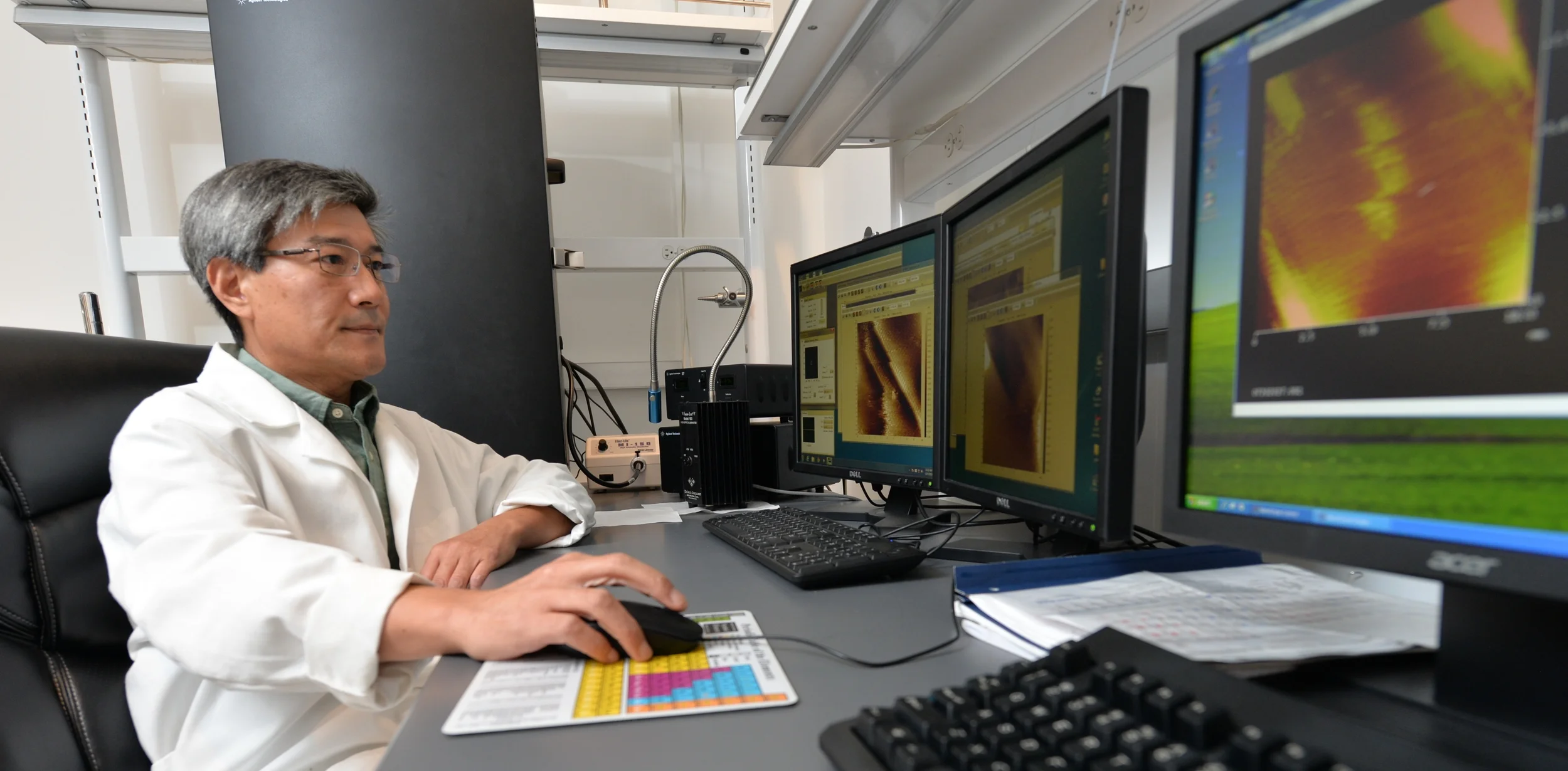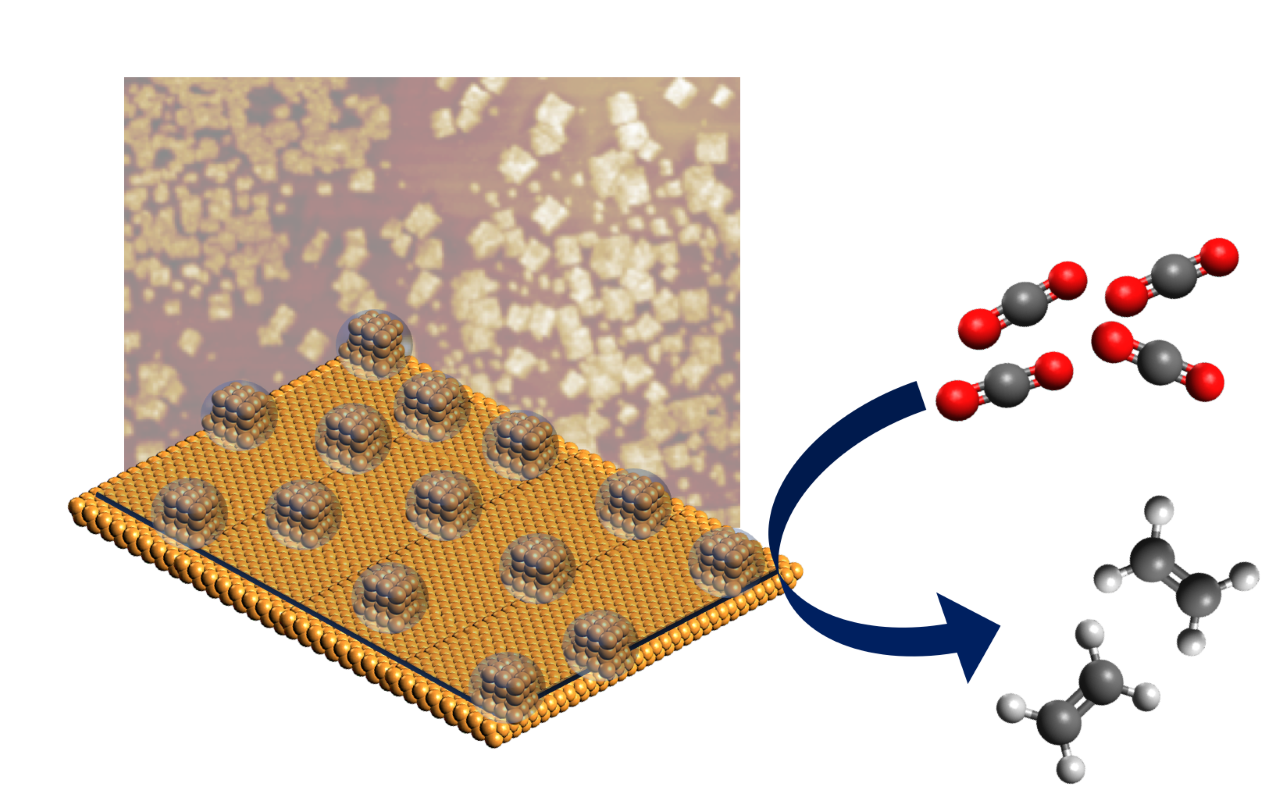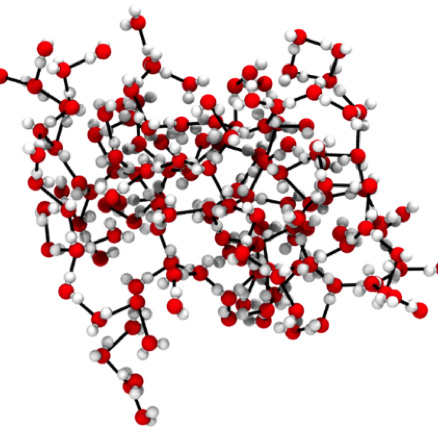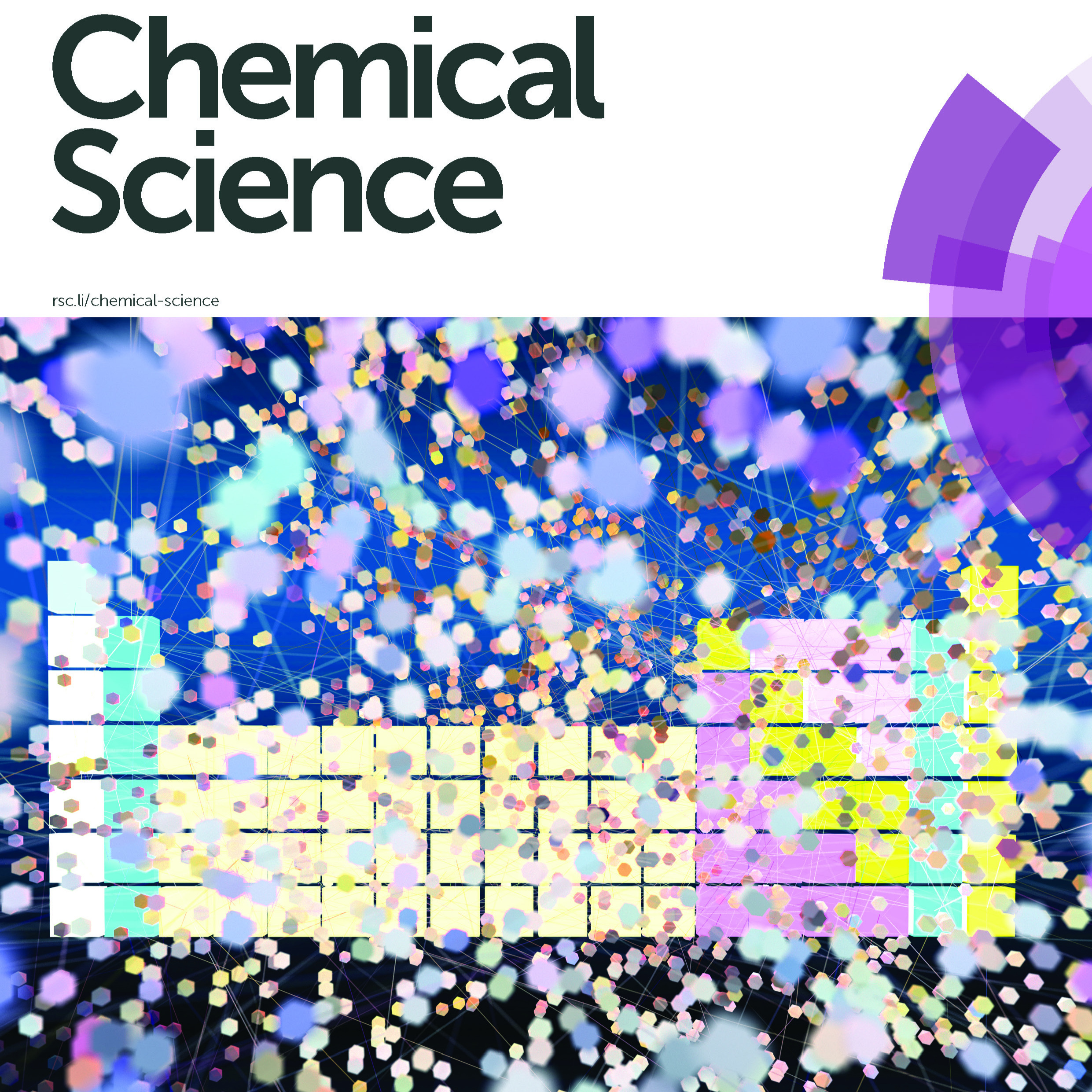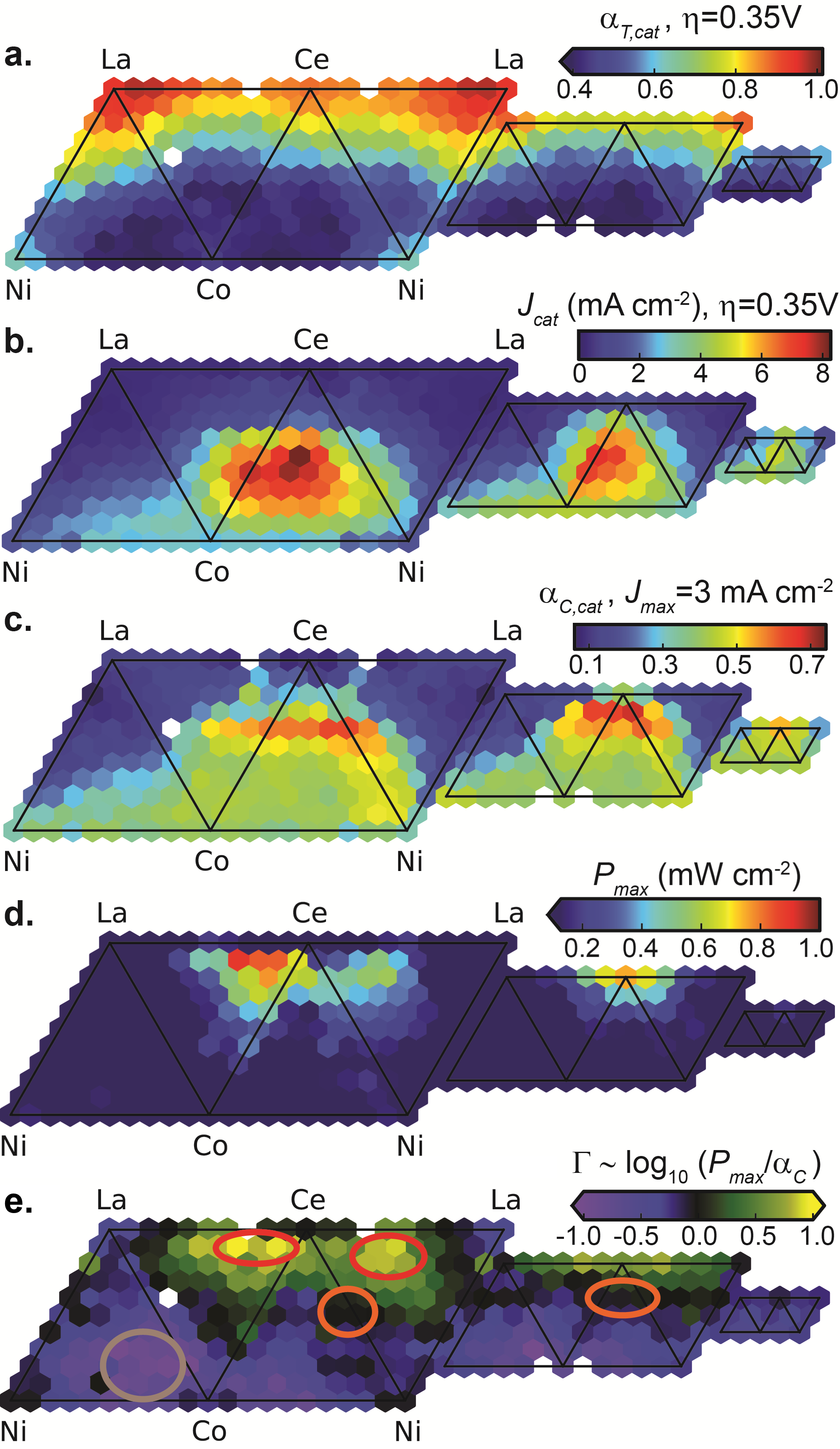CO2 to CO reduction with 19% Efficiency in a Solar-Driven Gas Diffusion Electrode Flow Cell
Efficient solar-driven CO2 reduction to CO was realized by integrating high-efficiency photovoltaics with performance-matched, reverse-assembled gas diffusion electrodes.
In situ Nanostructuring of Polycrystalline Cu by an Organic Additive Promotes Electrocatalytic CO2R to Ethylene
In this publication, we describe formation of Cu nanostructures with organic salt additives to achieve high efficiency conversion of CO2 to C2H4
Understanding the effects of electrolyte cations on the electrochemical reduction CO2
The effects of electrolyte cation size on the electrochemical reduction of CO2 over Ag and Cu are explained using theory
What it would take to source commodity chemicals from air?
The Science paper provides a technoeconomic and carbon emission analysis of possible products, offering targets that would need to be met for economically compelling industrial implementation to be achieved
photocatalysts for CO2 reduction: a data-driven materials discovery
In the largest photocathode search to date (i.e., starting with 68,860 candidate materials), the team identified 39 new photocathodes, which have never been experimentally tested before
Even-handed subsystem selection in projection-based embedding
Embedding methods for electronic structure can provide accurate description of chemical reactions at a reduced computational cost by treating different parts of chemical systems with a different levels of theory
Liquid Water is a Dynamic Polydisperse hyperBranched Polymer
Because of JCAP’s interest in developing new catalysts for using solar energy to convert water into fuels and to convert CO2 into organic materials and fuels, the Caltech team is developing a new force field theory that would match very accurately the full quantum mechanics description of water
Integrated Photoelectrochemical Cell (PEC) under Various Feed Conditions for Solar Water Splitting
Joint work between JCAP and DOE EERE HydroGen programs yielded a publication detailing performance of membrane-electrode-assembly photoeletcrochemical cells for solar water splitting
Pb-Activated Amine-Assisted Photocatalytic Hydrogen Evolution Reaction on Organic–Inorganic Perovskites
Investigation of reaction mechanism for explicit aqueous solvent quantum mechanics (QM) studies determining the energetics and reaction barriers for the photocatalytic hydrogen evolution reaction (HER) on CH3NH3PbI3 surface
Interface engineering for light-driven water oxidation: unravelling the passivating and catalytic mechanism in photoanodes
The complementary use of macroscopic photoelectrochemical measurements and nanoscale atomic force microscopy techniques provide foundational knowledge of interface engineering in integrated photoactive materials for solar fuel production
FeWO4 Photoanodes with Unmatched Performance
Through combinatorial exploration of composition space, highly absorbing films containing the FeWO4 phase were discovered, exhibiting a sub-2 eV band gap, operational stability, and high photovoltage
Product Selective Active Sites for Electrochemical CO2 Reduction
JCAP Researchers Joel Ager and Yanwei Lam discover copper has potential as a catalyst for turning CO2 into sustainable chemicals and fuels
Machine Learning of Materials’ Optical Properties
Generative models learn data relationships that enable predictions in unexplored spaces, and this seminal demonstration in experimental materials science provides guidance on how to deploy machine learning for materials discovery
Gas-Diffusion Electrodes for Carbon Dioxide Reduction: A New Paradigm
Vapor-fed reactors represent new paradigms for unprecedented control of local reaction conditions
Effects of Anion Identity and Concentration on Electrochemical Reduction of CO2
By choice of electrolyte anions with a high pKa, product selectivity can be shifted from H2 and CH4 to C2 products.
High Rate Electrochemical Reduction of CO to Ethylene using Gas Diffusion Electrodes
Direct gas feed configurations, such as flow-through GDEs, provide a unique electrode structure for efficient and stable electrochemical reactions without mass transport limitations.
Discovery of a stable solar fuels photonanode with ideal band gap
Combining high throughput experimentation with theory enabled discovery of a unique solar fuels photoanode with strong visible light absorption and remarkable stability.
Engineering Copper surfaces for the electrocatalytic conversion of CO2: Controlling selectivity toward oxygenates and hydrocarbons
In this study we control the surface structure of Cu thin-film catalysts to probe the relationship between active sites and catalytic activity for the electroreduction of CO2 to fuels and chemicals.
Combining Artificial Intelligence with Combinatorial X-ray Diffraction Enables Rapid Phase Mapping of New Materials
JCAP’s high-throughput team has partnered with computer scientists from Cornell University to develop a new method for rapid construction of phase diagrams using data from JCAP’s collaboration with Stanford Synchrotron Radiation Lightsource Laboratory.
Understanding Efficiency Limits of the Photoelectrochemical Devices
New analysis provides insight into factors that govern photoelectrochemical device performance .
JCAP researchers conducted Computational Investigation of single-atom bimetallic alloys
Proposed mechanism suggests that single-atom bimetallic alloys behave as a “one-pot” tandem catalysts, reducing CO2 to C1 hydrocarbon products.
JCAP researchers determined CO2RR reaction mechanisms from Quantum Mechanics free energy Calculations with Explicit water
Quantum Mechanics calculations with a realistic description of water were used to determine the mechanisms from free energy barriers of CO2RR providing an opportunity to use such calculations for designing new selective and active CO2RR catalysts.
JCAP Researchers successfully use combinatorial science to accelerate materials development for solar flues applications
JCAP’s high-throughput experimentation team together with scientists from SSRLdevelop a strategy to enable structure-property mapping of promising light absorbers.
Solar-Driven Reduction of CO2 to Formate at 10% Energy-Conversion Efficiency
Researchers assembled and characterized a device that under 1 Sun illumination operates in two electrolytes with different pHs and reduces CO2 to formate.
Defective TiO2 with high photoconductive gain for efficient and stable planar heterojunction perovskite solar cells
Long-term stability and high efficiency from planar heterojunction halide perovskites is enabled by addressing interfacial degradation and charge transfer resistance limitations.
Modeling, Simulation, and Implementation of Solar-Driven Water-Splitting Devices
JCAP researchers produced a review article on modeling and development of integrated solar-driven water-splitting devices
Stability and Self-Passivation of Copper Vanadate Photoanodes
Self-passivation under operational conditions is observed for several copper vanadate photoanodes, demonstrating their viability for durable solar fuels devices
Reduction of CO2 and CO using Bifunctional alloys
Density functional theory is used to study the reduction of CO2 and CO to hydrocarbons through a formyl pathway on alloys with an A3B composition
CO2 electrochemical reduction catalyzed by bimetallic materials at low overpotential
Electrocatalytic reduction of CO2 to highly reduced C2 and C1 products was accomplished on three different phases of nickel-gallium films at low overpotentials
Recent advances in understanding of hot carrier dynamics in chemical systems and solids for energy conversion and catalysis applications
Understanding the mechanisms and factors that govern plasmon energy conversion into hot carries is one of the first steps toward design of efficient materials that can harvest solar energy and catalyze CO2 conversion to fuels.
Efficient Solar-Driven Hydrogen-generating Device Featuring Protected Photoelectrochemical Assembly with Earth-abundant Catalysts
This work demonstrates that protection layers significantly improved the stability of efficient III-V tandem photoelectrodes, that produce thephotovoltage needed to sustain efficient, unassisted hydrogen production.
Photoanode Development Through Combinatorial Integration of mixed-metal Oxide Catalysts on Bismuth vanadate
High-throughput characterization can enable identification of integrated photoanodes assemblies and demonstrates importance of interface engineering
Assembly and Photocarrier Dynamics of Heterostructured Nanocomposite Photoanodes from Multicomponent Colloidal Nanocrystals
Finely-tailored complex materials were studied to demonstrate their functionality as promising light absorbers.
HOW CAN THEORY HELP WITH RAPID SCREENING OF PROMISING PHOTOCATALYSTS IN SOLVENT?
JCAP scientists are developing novel theoretical methods to predict the effect that solvents have on material properties - and consequently the photoelectrochemical performance - inside solar-fuels generators.
DETAILED INVESTIGATION OF THE ROLE OF SURFACE MOTIFS ON THE BEHAVIOR OF P-WSE2PHOTOCATHODES
The study revealed variations in the photoelectrochemical performance due to microscopic terraces in p-WSe2 photocathodes.
AN ELECTROCHEMICAL REDUCTION OF CO2 EXCLUSIVELY TO METHANOL
The present experimental study used differential electrochemical mass spectrometry (DEMS) focused on product selectivity towards methanol to test the theoretical prediction of selective heterogeneous CO2 reduction to methanol by a bimetallic near-surface alloy.
JCAP’S HARRY ATWATER ON CRITICAL ENERGY ISSUES (ECS PODCAST)
JCAP Director Harry Atwater in conversation with the Electrochemical Society’s Executive Director Roque Calvo on the eve of the fifth international ECS Electrochemical Energy Summit.
Band Gap Tunability in Sb-Alloyed BiVO4 Quaternary Oxides as Visible-Light Absorbers for Solar Fuel Applications
A photoanode material was discovered using a synthetic approach that may aid in future material discovery.
JCAP Researchers Integrate Theory and Experiment to Discover Novel Photoanodes and Pave the Way for Materials-by-Design Techniques
JCAP’s high-throughput experimentation and theory teams develop a means for rapid identification of the most promising classes of photoelectrochemical materials.
A High-Performance Si Microwire Photocathode Coupled with Ni–Mo Catalyst
Demonstration of a hydrogen-evolving Si-based photoelectrode that exhibits high photocurrent densities and catalytic activities, while using a high mass-loading of an earth-abundant electrocatalyst.
Interface Engineering for Stable, High-Performance Photoanodes
Multifunctional NiOx coatings enable the use of small-band-gap non-oxide semiconductors as photoanodes in integrated and efficient water-splitting systems.
p-Type Transparent Conducting Oxide/n-Type Semiconductor Heterojunctions for Efficient and Stable Solar Water Oxidation
A study of oxide-based protection and passivation layers designed to prevent corrosion in photoanodes.
Direct Observation of a Semiconductor/Liquid Junction by Operando X-Ray Photoelectron Spectroscopy (XPS)
Operando XPS is used to directly measure the positions of the electronic states of the electrode and the electrolyte.
Fabrication of High Efficiency Perovskite Solar Cells
Novel method for deposition of continuous, pinhole-free methylammonium trihalide perovskites with controlled composition and improved texture.
Transparent Catalytic Nickel Oxide Protecting Films for Photoanodes
Reactively sputtered nickel oxide provides a transparent, catalytic, and conductive layer that stabilizes many efficient and technologically important semiconducting photoanodes.
High-Throughput Synchrotron X-Ray Experimentation for Combinatorial Phase Matching
JCAP worked closely with SLAC beamline scientists and the broader combinatorial materials science community to establish high-throughput X-ray experiments.
Origin of High OER Activity in Ni/Fe Oxyhydroxides
The role of iron in the performance of oxygen-evolving reaction catalysts was investigated using density-functional theory and beamline X-ray techniques.
Hot-Carrier Generation from Plasmon Decay in Energy Conversion
Theoretical study combining plasmon modes with density functional theory to predict initial energy distribution of hot carriers in real metals.
STABILIZED SI MICROWIRE ARRAYS FOR SOLAR-DRIVEN H2O OXIDATION
An amorphous, atomic-layer-deposited (ALD) TiO2 coating shown to provide chemical protection, transparency to solar irradiation, and conductivity to holes on planar semiconductors has been extended to three-dimensionally structured Si microwire array devices.
Computational and Experimental Identification of an Earth-Abundant Light Absorber for Solar Water Splitting
Using a combination of experiment and theory, a complex oxide is identified to exhibit a band gap and band edges that are near optimal for photocatalytic water splitting.
Unique Nanostructure Revealed in New OER Electrocatalyst
Using high-throughput experimentation, microscopy, and synchrotron characterization, JCAP discovered a new oxygen-evolution-reaction catalyst.
Selective Reduction of CO2 to Methane
Preliminary study of selective electrochemical 8e−/8H+ reduction of CO2 to methane.

